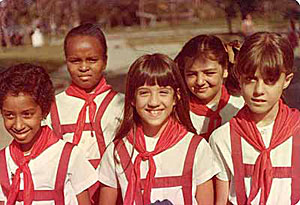
Blindsight (UK, director Lucy Walker): I loved this, and not just for the obvious reasons. Blindsight is a documentary about a group of blind Tibetan teenagers who attempt to climb one of Mount Everest’s sister peaks. Now, this kind of thing is usually a can’t miss. Inspirational. Moving. Pretty standard, right? And even if the film were just that, I’d still have liked it. But it was so much more. Blind herself, German Sabriye Tenberken established a school for blind children in Tibet, in a culture that sees blindness as a curse, as evidence that a person did bad things in a previous life. Many of the children at the school have been shunned their whole lives, and at best, are a burden to their families. As part of their education, Tenberken shares with them the story of American Erik Weihenmayer, the first blind person to reach the summit of Mount Everest. She sends him a letter inviting him to come and visit her students. Instead, he comes up with a plan. He’ll arrange an expedition for them to climb 23,000 foot Lhakpa Ri and provide all the guides and equipment. Sabriye finds six willing participants and this is when the fun starts.
Erik’s team are mostly American, mostly male, and mostly sighted. As experienced mountaineers, they’re Type-A personalities, very gung-ho and goal-oriented. Sabriye is European, female, and blind, and the students for her are more than a “project,” no matter how well-intentioned. Additionally, the students are Tibetan, and not old enough or confident enough to always stand up for themselves. As the expedition unfolds, they become pawns in between the two adult “sides,” wanting to please both, while at the same time wanting to gain the confidence that comes from accomplishment. As an additional obstacle (other than being blind, that is), they are speaking English as a second or in most cases, a third language, and struggle to understand and make themselves understood.
When it turns out that none of the students have any climbing experience, and that some are much more coordinated than others, it begins to unravel Erik’s original plan for them all to reach the summit together. As both students and teachers begin to suffer the effects of high altitude, decisions must be made as to whether to continue on or to send some down the mountain. Among the effects of high altitude is increased irritability, and you can see how this feeds the conflict between the adults. At the risk of oversimplifying, on one side are those for whom the destination is all, and on the other are those who just want to enjoy the journey. I won’t tell you how it all turns out, except to say that this was one of the most surprising and thought-provoking stories I’ve seen in a long time.
The film also weaves bits of each climber’s story into the narrative, and this was sorely needed, since once on the climb, the kids tended to keep their heads down and their mouths shut. With all the drama going on around them, that wasn’t surprising. The backstories are by turns charming and heartbreaking, and I found it very strange that I found myself closer to tears at the beginning of the film than at the end. This was contrary to my expectations, and another pleasant surprise.
In addition to all the human drama to cover, director Walker and her small crew had to contend with the frigid and oxygen-deprived conditions herself, lugging equipment up the mountains and hoping it wouldn’t break down. As with all great documentaries, the filmmaker was just lucky enough (or smart enough, or prepared enough) to be at the right place at the right time, and she’s captured a very special story that has as much to say about people who want to do “what’s best for the kids” as it does about the kids themselves.
Braille Without Borders (Sabriye Tenberken’s organization)
 (10/10)
(10/10)

 (6/10)
(6/10)
 (7/10)
(7/10)
 (9/10)
(9/10)